|
|
Designer
Snowflakes - Part Two
... Better snowflakes ... |
|
Our initial successes
(see Part
One) showed that it was possible to grow some excellent designer snow crystals on the
ends of electric ice needles. But getting everything working right -- the
temperature, humidity, and optics -- was going to be difficult. |
| Better
Hardware ... |
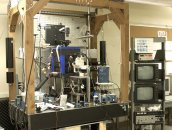 Our simple diffusion chamber wasn't sufficient to engineer
really nice snowflakes, so we built a new and improved snowflake growing machine. We
did some systematic studies of electrically modified crystal growth with this chamber, and
along the way we took more pictures. Our simple diffusion chamber wasn't sufficient to engineer
really nice snowflakes, so we built a new and improved snowflake growing machine. We
did some systematic studies of electrically modified crystal growth with this chamber, and
along the way we took more pictures.
Along with a better chamber, we also used a high-quality long-distace
microscope, along with a large-format CCD camera, to get substantially better photographs.
|
| ...
makes Better Snowflakes |
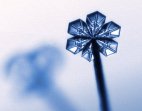 This image shows a small plate-like crystal, which was grown at a temperature
of about -13 C, slightly warmer than the dendrite peak (see the snow crystal
primer for details). As with most of the snow crystals displayed here, the crystal was
created by first growing a thin "electric" ice needle (click here for
details). Once the ice needle had reached the desired length, the high voltage was turned
off, and the crystal was moved to a region in the growth chamber that had the desired
temperature. At this point the plate-like crystal began growing at the needle's tip. This image shows a small plate-like crystal, which was grown at a temperature
of about -13 C, slightly warmer than the dendrite peak (see the snow crystal
primer for details). As with most of the snow crystals displayed here, the crystal was
created by first growing a thin "electric" ice needle (click here for
details). Once the ice needle had reached the desired length, the high voltage was turned
off, and the crystal was moved to a region in the growth chamber that had the desired
temperature. At this point the plate-like crystal began growing at the needle's tip.
The tip-to-tip diameter of this crystal is about 0.6 mm, which took about
ten minutes to grow. The water vapor supersaturation level was not measured with high
accuracy, but here is estimated to be around the water saturation level.
Note the sectored plates in this crystal, some of which are strongly
reflecting the light, and the characteristic ribs on the plates. The "shadow" in
the lower left of the image is in fact another growing snow crystal, behind the one the
camera is focused on. |
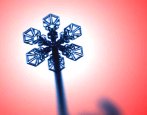 In this image one sees another example of sectored plates. This crystal began
growing close to the dendrite peak, so that six dendritic arms sprouted from the needle
tip. Because the supersaturation level was low, the arms exhibited only slight
sidebranching. After the arms had developed, the crystal temperature was raised a few
degrees, and the supersaturation level was reduced, then favoring the development of
sectored plates at the ends of the dendritic arms. Finally, near the end of the crystal
growth the temperature was again lowered to the dendrite peak, which caused ridges to form
along the outermost edges of the sectored plates. The crystal diameter is about 0.8 mm.
In this image one sees another example of sectored plates. This crystal began
growing close to the dendrite peak, so that six dendritic arms sprouted from the needle
tip. Because the supersaturation level was low, the arms exhibited only slight
sidebranching. After the arms had developed, the crystal temperature was raised a few
degrees, and the supersaturation level was reduced, then favoring the development of
sectored plates at the ends of the dendritic arms. Finally, near the end of the crystal
growth the temperature was again lowered to the dendrite peak, which caused ridges to form
along the outermost edges of the sectored plates. The crystal diameter is about 0.8 mm.
All the images shown on this page were originally acquired in
black-and-white using a megapixel CCD camera. The images were cleaned and processed to
varying degrees using PhotoShop, and color was added for artistic effect. |
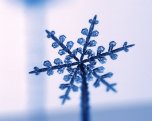 Here's a good example of a designer snowflake. It was grown at about -14 C,
quite near the dendrite peak, and at a fairly low supersaturation. Under these conditions
the needle tip immediately sprouted six dendritic arms. At various times during growth the
crystal was moved to -7 C for just a few seconds, and then moved back to -14 C; this
operation caused a pair of sidebranches to sprout from each of the six main arms. All the
sidebranches on the crystal were induced using this procedure; none grew otherwise.
Tip-to-tip diameter is 1.8 mm.
Here's a good example of a designer snowflake. It was grown at about -14 C,
quite near the dendrite peak, and at a fairly low supersaturation. Under these conditions
the needle tip immediately sprouted six dendritic arms. At various times during growth the
crystal was moved to -7 C for just a few seconds, and then moved back to -14 C; this
operation caused a pair of sidebranches to sprout from each of the six main arms. All the
sidebranches on the crystal were induced using this procedure; none grew otherwise.
Tip-to-tip diameter is 1.8 mm.
This crystal also demonstrates the phenomenon of kinetic roughening. At the
tips of the main arms the supersaturation is high, making the tips rounded. Closer to the
center of the crystal the supersaturation is lower, and thus the sidebranches are faceted.
See Snowflake Movies
for a movie of this crystal growing. |
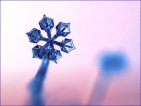 This crystal began at -15 C, where six branchless dendritic arms grew from
the needle tip. Once the arms had grown a bit, the crystal temperature was raised to -13 C
and the supersaturation was reduced. Then sectored plates proceeded to grow from the ends
of the dendritic arms. Right before the picture was taken the crystal was moved to -15 C
again, and dendritic arms just started growing from the tips of the sectored plates.
Diameter is about 0.8 mm.
This crystal began at -15 C, where six branchless dendritic arms grew from
the needle tip. Once the arms had grown a bit, the crystal temperature was raised to -13 C
and the supersaturation was reduced. Then sectored plates proceeded to grow from the ends
of the dendritic arms. Right before the picture was taken the crystal was moved to -15 C
again, and dendritic arms just started growing from the tips of the sectored plates.
Diameter is about 0.8 mm. |
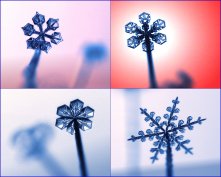
At right is a combined image of the above four. Click
on the image for a full-sized version.. The sizes and growth conditions of the various
crystals are given above. Growth times varied from about 15 - 45 minutes. Dendritic arms
grow at typically 1 - 3 microns/second, which can produce a 1 mm diameter crystal in about
5 minutes. Sectored plates, on the other hand, grow more slowly. |
| 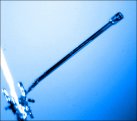 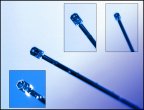 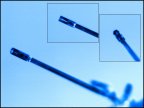 Here are several examples of hollow columns grown at the ends
of electric needles. For each of these crystals, once the electric needle had grown to
some length (at a temperature of -4 C, just above the needle peak), the voltage was turned
off and the crystal moved to a slightly lower temperature area. At this point a hollow
column grew at the needle tip, while the rest of the needle slowly thickened. The first
image shows a crystal grown at about -8 C. The second image shows a crystal grown at about
-9 C; the two upper inset views show early times during the growth; the lower inset shows
a end-on view, with light reflecting from the rim of the column. The third image shows a
crystal grown near -7 C, producing a somewhat longer, thinner column. Here are several examples of hollow columns grown at the ends
of electric needles. For each of these crystals, once the electric needle had grown to
some length (at a temperature of -4 C, just above the needle peak), the voltage was turned
off and the crystal moved to a slightly lower temperature area. At this point a hollow
column grew at the needle tip, while the rest of the needle slowly thickened. The first
image shows a crystal grown at about -8 C. The second image shows a crystal grown at about
-9 C; the two upper inset views show early times during the growth; the lower inset shows
a end-on view, with light reflecting from the rim of the column. The third image shows a
crystal grown near -7 C, producing a somewhat longer, thinner column.
|
|  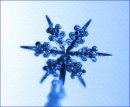 More dendritic designer crystals. The one on the left was grown
near -15 C, with excursions to a slightly higher temperature to promote sidebranching. The
final phase of growth was at -15 C, at which temperature the main arms grow rapidly in the
form of sharp spikes. The image on the right is side view of a dendritic start, early in
its growth. More dendritic designer crystals. The one on the left was grown
near -15 C, with excursions to a slightly higher temperature to promote sidebranching. The
final phase of growth was at -15 C, at which temperature the main arms grow rapidly in the
form of sharp spikes. The image on the right is side view of a dendritic start, early in
its growth.
|
| 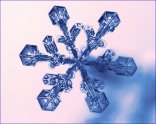 A fairly large crystal, approximately 2 mm in diameter. The ambient
temperature varied slightly during the crystal growth, changing from about -14 C to -13 C.
Note that there is a great deal of structure in the sectored plates at the ends of the
arms, reflecting the somewhat higher supersaturation (compared to the pictures above)
during growth.
A fairly large crystal, approximately 2 mm in diameter. The ambient
temperature varied slightly during the crystal growth, changing from about -14 C to -13 C.
Note that there is a great deal of structure in the sectored plates at the ends of the
arms, reflecting the somewhat higher supersaturation (compared to the pictures above)
during growth.
|
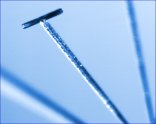  Electric needles can be coaxed to grow along different
crystallographic axes of ice, and these two columnar crystals formed on electric needles
that had grown along an a-axis. The first crystal was grown near -7 C, becoming a hollow
column (the hexagonal shape can be seen in the enlarged image). The second was grown at -5
C, showing a collection of thin ice needles. Note that the electric needles, grown along
an a-axis, are quite rough. This is in contrast to the previous images, where the electric
needles were grown along the c-axis, which can result in very smooth hexagonal needles,
the same shape as wooden pencils. Electric needles can be coaxed to grow along different
crystallographic axes of ice, and these two columnar crystals formed on electric needles
that had grown along an a-axis. The first crystal was grown near -7 C, becoming a hollow
column (the hexagonal shape can be seen in the enlarged image). The second was grown at -5
C, showing a collection of thin ice needles. Note that the electric needles, grown along
an a-axis, are quite rough. This is in contrast to the previous images, where the electric
needles were grown along the c-axis, which can result in very smooth hexagonal needles,
the same shape as wooden pencils. |
| 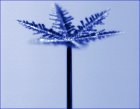 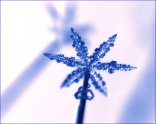 Left: Another snow star, grown near -13 C at fairly high
supersaturation. The dendritic arms show copious sidebranching in the form of small
plates. The electric needle evidently had small imperfections just below the tip, which
resulted in the growth of small plates below the main crystal. Note these small plates
have the same orientation as the main crystal, demonstrating that the entire assembly is a
single crystal. Right: An oblique view of a dendritic star, grown at -15 C and high
supersaturation, which produces many fern-like sidebranches on the main arms. Note how the
crystal grows upward, since the top basal surface is at a higher supersaturation level
than the lower surface. Left: Another snow star, grown near -13 C at fairly high
supersaturation. The dendritic arms show copious sidebranching in the form of small
plates. The electric needle evidently had small imperfections just below the tip, which
resulted in the growth of small plates below the main crystal. Note these small plates
have the same orientation as the main crystal, demonstrating that the entire assembly is a
single crystal. Right: An oblique view of a dendritic star, grown at -15 C and high
supersaturation, which produces many fern-like sidebranches on the main arms. Note how the
crystal grows upward, since the top basal surface is at a higher supersaturation level
than the lower surface.
|
| 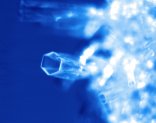 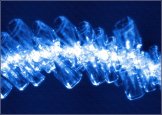 Left: A nice shot of a scroll-type hollow column, growing from
a clump of crystals. Note how one wall of the cup-shaped crystal is curled inward. Right:
a chain of hollow columns, growing at around -7 C with fairly high supersaturation. Left: A nice shot of a scroll-type hollow column, growing from
a clump of crystals. Note how one wall of the cup-shaped crystal is curled inward. Right:
a chain of hollow columns, growing at around -7 C with fairly high supersaturation.
|
|  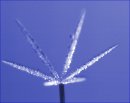 Left: A side-view
of a growing dendritic star, with thick, somewhat structured plates. Note the facets
visible in the supporting needle crystal. Right: A peculiar snow star, grown around -10 C
(midway between columns and plates), at high supersaturation. Left: A side-view
of a growing dendritic star, with thick, somewhat structured plates. Note the facets
visible in the supporting needle crystal. Right: A peculiar snow star, grown around -10 C
(midway between columns and plates), at high supersaturation.
|
| 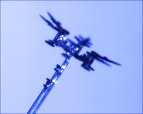  Another designer snowflake, which we call a "chandelier" crystal.
After growing an electric needle, the voltage was removed and the temperature lowered to
around -15 C to produce a small stellar crystal. This was then moved to about -7 C, which
caused hollow columns to grow from the tips of the stellar branches (left image). Finally,
this same crystal was again lowered to -15 C, resulting in more dendritic branches growing
out from the hollow columns (right image). From this perspective it is a bit difficult to
pick out all six branches of the crystal.
Another designer snowflake, which we call a "chandelier" crystal.
After growing an electric needle, the voltage was removed and the temperature lowered to
around -15 C to produce a small stellar crystal. This was then moved to about -7 C, which
caused hollow columns to grow from the tips of the stellar branches (left image). Finally,
this same crystal was again lowered to -15 C, resulting in more dendritic branches growing
out from the hollow columns (right image). From this perspective it is a bit difficult to
pick out all six branches of the crystal.
|
| 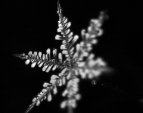 This image shows a dendritic
star crystal in light reflecting directly off the shiny flat surfaces of the plate-like
sidebranches (using a bright, point-source lamp for illumination). Similar, very flat,
basal facets are often seen on snow crystals falling in cold climates. This image shows a dendritic
star crystal in light reflecting directly off the shiny flat surfaces of the plate-like
sidebranches (using a bright, point-source lamp for illumination). Similar, very flat,
basal facets are often seen on snow crystals falling in cold climates.
|
|
